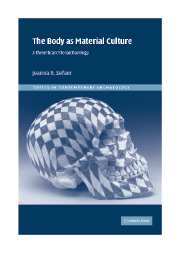2 - The body as an archaeological resource
Published online by Cambridge University Press: 05 June 2012
Summary
we continually walk a fine line between constructivism and the claim to authenticity made by bodily phenomena.
Benthien 2002: 12The body is a major class of archaeological evidence and a vital archaeological resource. From the moment of its discovery, the body forms a focus for analysis as it is excavated, photographed, drawn, described, lifted and finally removed, often to a laboratory for osteological examination. Bodies may be recorded separately from other finds on individual skeleton recording sheets (Museum of London Archaeology Service 1994; Parker Pearson 1999a), emphasising their privileged interpretative position. The single body is often taken as the basic unit of analysis in the mortuary domain (Chapman 2000: 174). Indeed, one measure of the importance of the body is that mortuary contexts are lent their classifications and denotation as ‘mortuary’ through the presence of a body.
Bodies have been studied in terms of their placement and arrangement, often by reference to orientation and position, with differences between bodies interpreted in terms of the categorisation of past individuals or social groups (e.g. Pader 1982; Lucy 2000). The treatment of the dead body and choice of means of its disposal, whether through cremation, inhumation, or its disarticulation and disaggregation, has been identified as a strong social statement and as a metaphor for social organisation (Parker Pearson 1999a). More recently, the deliberate fragmentation of bodies has been seen in terms of the enchainment of people and artefacts with a series of scales in the relationship between linked body parts of a single individual, groups of related whole bodies and sets of artefacts (Chapman 1999, 2000).
- Type
- Chapter
- Information
- The Body as Material CultureA Theoretical Osteoarchaeology, pp. 12 - 30Publisher: Cambridge University PressPrint publication year: 2006



